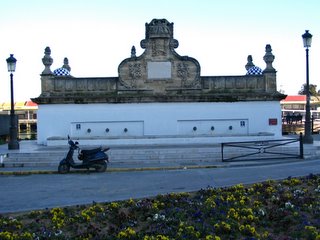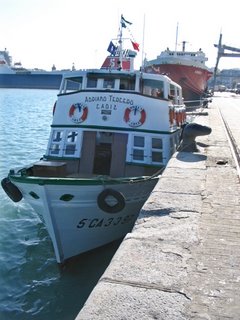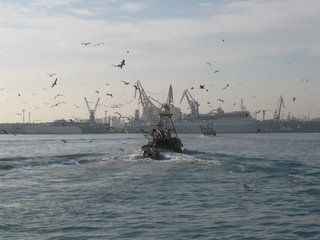Today has been very windy, too much so to really enjoy the day. We left Conil de la Frontera and made our way towards Cadiz via Chiclana de la Frontera where we stopped for fuel and shopping. When we were last in Cadiz we visited Chiclana de la Frontera which is famed for its wonderful sandy beach and is popular with surfers and scuba divers. We discovered then that the bus only goes as far as the town and the beach is about six kilometres further on. Today we simply wandered the streets of the old town. At 2pm they were snarled up with traffic and it was quite impossible to cross any of the roads. At 2.15 the town was deserted, the shutters were up at all the shops and we had the place to ourselves! Spain simply closes down until around 5pm.
We were delighted to see a pair of storks nesting on the belfry of the church of Jesus of Nazareth. Ian reckons he’s solved the miracle of the Immaculate Conception and the storks were still there after delivering baby Jesus at Christmas. (Back near La Linea we also saw storks sitting on their huge untidy nests alongside the railway line on top of nearly every gantry.)
 Storks at Chiclana de la Frontera
Storks at Chiclana de la FronteraWe discovered a friendly looking bar in one of the cobbled side lanes of the old town where we had cold drinks and a selection of tapas – stuffed mushrooms, fried fish, potato salad and seafood salad. It was a very pleasant experience with a bill of a mere eight euros.
Driving in towns is never easy and, excellent as Ian’s map-reading skills are, road works and diversions sometimes mean we are reliant on the road signs. These are frequently less than helpful as you can see and can leave us completely lost in a maze of one way narrow streets that take us around in circles.
 Do I go left or right Ian?
Do I go left or right Ian?We asked advice on campsites and parking in Cadiz at the tourist office in Chiclana. The lady was really helpful, as we have found whenever we have sought tourist advice in Spain. There was no campsite open at Cadiz or Chiclana but a phone call confirmed that this site was open. So we by-passed Cadiz and arrived here at Puerto de Santa Maria on the opposite side of the harbour to Cadiz. There is a ferry we plan to take tomorrow across the bay which should leave us in the old town without even needing to take Modestine off this campsite.
Puerto de Santa Maria, like Jerez, is famed as a sherry producing town, full of bodegas where it is possible to visit the cellars, learn the history of sherry production and of course enjoy a tasting. Usually the name Tio Pepe in Jerez is synonymous with sherry but there are numerous other marks and exporters. Here one of the main producers is Osborne, with a massive bodega in the centre of the town and a seductive aroma of sherry that pervades all the surrounding streets.
 Osborne’s Bodega in Puerto de Santa Maria
Osborne’s Bodega in Puerto de Santa MariaThis evening we explored the streets of Puerto, which seems a very pleasant place, clean, with several parks and open areas. There are streets of attractive old houses with massive, elaborately carved doors, stone porticos and lovely enclosed balconies so typical of Spanish buildings of the 18th century. Near the campsite there is a seafront promenade lined with palm trees and flower beds and a wide sandy beach
 Doorway in Puerto de Santa Maria
Doorway in Puerto de Santa MariaWednesday 8th February 2006, Puerto de Santa Maria, near Cadiz
We were up before daylight this morning! By 9 a.m. we had walked the three kilometres to the quayside on the river Guadalete near the town centre, leaving Modestine secure beneath the pine trees on our campsite.
Beside the landing stage for the ferry to Cadiz we discovered the fountain that was used during the 18th century to replenish the Spanish ships travelling to the New World. The ferry proved to be a lovely old boat with wooden seats that has been plying its way across the bay since the 1920s and has recently been declared a national cultural asset. This morning it made the 45 minute trip for just five passengers and the return fare was only 4 euros each. It cannot possible be financially viable, though is probably busier during the summer. Throughout the crossing we were accompanied by various fishing boats, followed by huge flights of seabirds, as they returned to port in Cadiz. On arriving we discovered the landing stage for our little old boat is the same one as used by the regular ferries travelling between Cadiz and the Canary Islands! Wonder how long that journey would take? Would Modestine enjoy Tenerife? Dream on.
 18th century fountain in Puerto de Santa Maria
18th century fountain in Puerto de Santa Maria Ferry to Cadiz from Puerto de Santa Maria
Ferry to Cadiz from Puerto de Santa Maria Puerto de Santa Maria seen from the river
Puerto de Santa Maria seen from the river Bringing in the catch, Cadiz
Bringing in the catch, CadizCadiz is almost an island, surrounded by sea on three sides and normally reached by a long narrow causeway across empty, flat, deserted marshland populated by sea birds, egrets, herons and dunlins. Everywhere it seems, the sea is visible. The city is situated at the south–west corner of Spain, surrounded by the Atlantic and can be subject to very strong winds. Those blowing north from Africa can be very agreeable in winter, but those from the Atlantic can be icy cold.
 John Roque’s 18th century map of the Bay of Cadiz
John Roque’s 18th century map of the Bay of CadizIt has always been of strategic military importance and has suffered attacks from raiders and privateers including Sir Francis Drake during the 16th century when the British set fire to the Spanish fleet moored here.
It really did seem very strange finding ourselves plunged into the heart of the old city and realising we knew our way around without any need for a map. Until we landed we thought we had forgotten the town, but everything about it was so familiar. It was after all, only nine months since we had last visited. There was a tinge of sadness that, having promised Kate we would come to Cadiz in Modestine, we arrive too late for her to meet us here. We walked through the old town to the flat she left just a few weeks back. On the balcony several of her plant pots were still standing, presumably inherited by the new occupants.
 Mum calls but there is nobody there
Mum calls but there is nobody thereKate’s 18th century flat in Cadiz
Around the corner we looked in on the wonderful market for which the town is famed with its colourful displays of fruit and vegetables, its cheeses and dairy produce and its meat market. The most fascinating displays though were the fish and seafood. Surrounded by seas that team with life, these take the main role in local cuisine. There are the usual fish of course – hake, cod, and tuna – but there are also squid, octopus and cuttlefish. There are crabs, prawns, lobsters and all manner of shellfish.
 Octopus in the market, Cadiz
Octopus in the market, CadizWe walked around the narrow cobbled streets lined with small shops and cafes, frequently opening into little shady squares with palm trees and lovely white rendered churches.
 Iglesia de San Francisco, Cadiz
Iglesia de San Francisco, CadizOn this visit we went into the Women’s Hospital, a handsome 18th century building surrounding a cool, plant-filled courtyard with ceramic tiles depicting the stations of the cross around its walls. From one corner a door led to a baroque chapel with various side chapels and a rather dark, grisaille painting of St. Francis of Assisi by El Greco. The hospital also has an architectural masterpiece of a staircase that is truly beautiful as well as functional.
 Courtyard of the Women’s Hospital, Cadiz
Courtyard of the Women’s Hospital, Cadiz Station of the Cross in the courtyard of the Women’s Hospital, Cadiz
Station of the Cross in the courtyard of the Women’s Hospital, Cadiz Chapel of the Women’s Hospital, Cadiz
Chapel of the Women’s Hospital, Cadiz El Greco’s St. Francis of Assisi in the Chapel of the Women’s Hospital, Cadiz
El Greco’s St. Francis of Assisi in the Chapel of the Women’s Hospital, Cadiz Base of the staircase in the Women’s Hospital, Cadiz
Base of the staircase in the Women’s Hospital, Cadiz Top of the staircase in the Women’s Hospital, Cadiz
Top of the staircase in the Women’s Hospital, Cadiz Upper Gallery in the Women’s Hospital, Cadiz
Upper Gallery in the Women’s Hospital, CadizOur tour around the city took in the old theatre, the medical school, the beautiful Genovés Park with its small lake, water fall, grotto, palm trees, topiary and noisy green parrots nesting high in the leaves of the palm trees. We paid our respects to the ducks, at least three of which have been resident in their early days in Kate and Joe’s flat when they rescued them as fledglings and kept them in the bath until big enough to survive! They released them into the park before returning to England! Which were the orphans we will never know but they all looked healthy and happy.
 Falla Theatre, a 19th century piece of Moorish nonsense, Cadiz
Falla Theatre, a 19th century piece of Moorish nonsense, Cadiz Kate’s waifs and strays? Cadiz
Kate’s waifs and strays? CadizNext we explored the defensive walls overlooking the bay. This is a lovely walk on such a sunny day with the blue sea lapping the base of the old brown coarse stone walls with its picturesque watch towers.
 Defensive walls, Cadiz
Defensive walls, CadizThere was an excellent exhibition in the old fort of the Castillo Santa Catalina on the maritime, trading and military history of Cadiz. Far too much to take in today though. The city at one time had over 100 watch towers built onto the roofs of important houses from where merchants could look out to sea searching for their vessels returning from the New World. One of these towers, the Torre Tavira, today holds the camera obscura, which gives a wonderful panoramic view over the town by use of lenses reflected onto a round table top.
 Chapel and courtyard of the Castillo Santa Catalina, Cadiz
Chapel and courtyard of the Castillo Santa Catalina, Cadiz 17th century merchant’s house with four watch-towers, Cadiz
17th century merchant’s house with four watch-towers, CadizWe stopped for cold beer, fried fish and, deciding to be adventurous, fried cuttlefish. The fish was delicious but the cuttlefish was a just heap of tentacles that were really chewy, like rubber bands with suction pads! An experience, but we probably won’t bother again. It was wonderful sitting on the beach beneath a sunshade as we ate though and the beer was icy cold.
We continued our walk along the causeway out to the Castillo de San Sebastian, a place charged with memories as we spent a very happy evening there with Kate and Joe watching crabs and exploring the really deep holes the sea has gouged into the rocks from below, where it has eroded beneath them. From here there were good views back to the city and the Cathedral.
 Castillo de San Sebastian, Cadiz
Castillo de San Sebastian, Cadiz Cathedral, Cadiz
Cathedral, CadizIt is quite impossible to do justice to Cadiz in this brief account, just as it has been impossible to do more than spend a delightful day revisiting old haunts and discovering a few new ones. Although not famed like Seville or Jerez for its Moorish alcazars, Cadiz has a unique setting, a wealth of beautiful buildings and is surely one of Spain’s unheralded treasures.
Towards late afternoon we stopped for ices at the Plaza San Juan de Dios, a beautiful tree-lined area near the imposing town hall before making our way back to the ferry terminal via the Plaza de España with its massive Monumento a los Cortes commemorating the first liberal constitution of 1812.
 Town Hall on the Plaza San Juan de Dios, Cadiz
Town Hall on the Plaza San Juan de Dios, Cadiz Monumento a los Cortes, Plaza de España, Cadiz
Monumento a los Cortes, Plaza de España, Cadiz(You can see a further selection of images of Cadiz on our
blogsite from the visit we made in April 2005. )
The return trip across the bay in the sunshine was delightful but by the time we disembarked the air was turning chilly. We walked “home” to Modestine through the town of Puerto de Santa Maria, where we discovered the 12th century Moorish Castillo San Marcos. It has been a very full day and we are both footsore and exhausted, but it has been worth every minute.
 Castillo San Marcos, Puerto de Santa Maria
Castillo San Marcos, Puerto de Santa Maria